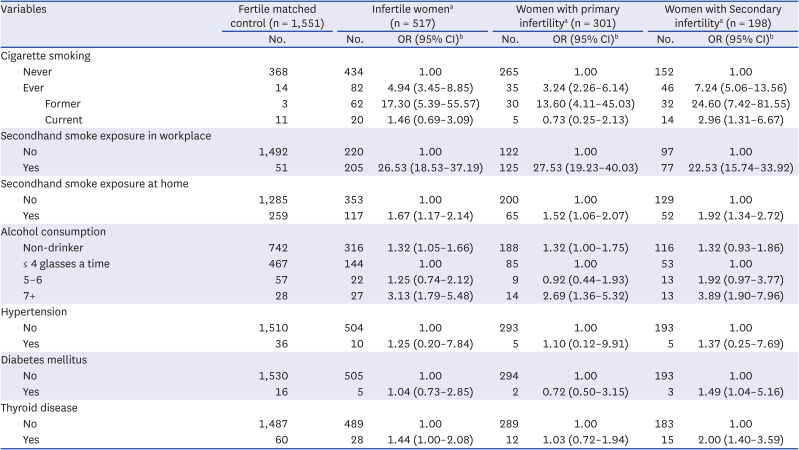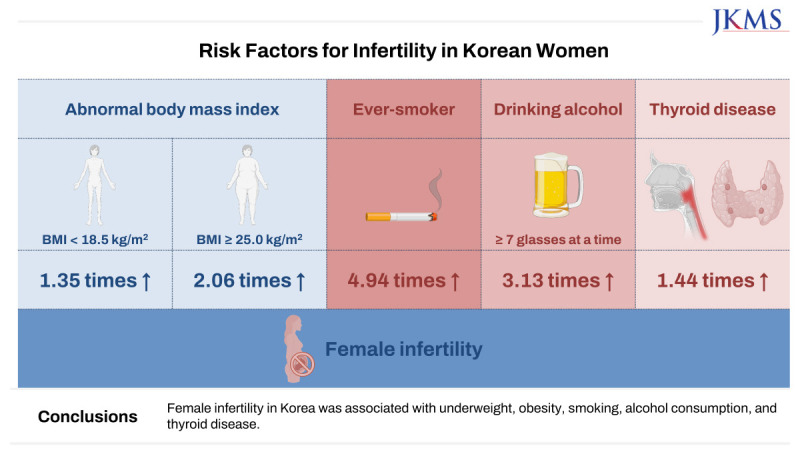1. World Health Organization. ICD-10 International Classification of Diseases. Geneva, Switzerland: World Health Organization;1993.
2. Hwang N, Jang I. Factors influencing the depression level of couples participating in the national supporting program for infertile couples. J Korean Acad Community Health Nurs. 2015; 26(3):179–189.

3. Pal S. Prevalence of infertility and its treatment among women. US Pharm. 2018; 43(9):14.
4. Ghuman N, Ramalingam M. Male infertility. Obstetrics, Gynaecol Reprod Med. 2018; 28(1):7–14.

5. Klein EJ, Vrees R, Frishman GN. Female infertility. Falcone T, Hurd WW, editors. Clinical Reproductive Medicine and Surgery: a Practical Guide. Cham, Switzerland: Springer;2022. p. 281–301.
6. Sharma R, Biedenharn KR, Fedor JM, Agarwal A. Lifestyle factors and reproductive health: taking control of your fertility. Reprod Biol Endocrinol. 2013; 11(1):66. PMID:
23870423.
7. Shah K, Sivapalan G, Gibbons N, Tempest H, Griffin DK. The genetic basis of infertility. Reproduction. 2003; 126(1):13–25. PMID:
12814343.
8. Shin HY, Kang HT. Recent trends in the prevalence of underweight, overweight, and obesity in Korean adults: the Korean National Health and Nutrition Examination Survey from 1998 to 2014. J Epidemiol. 2017; 27(9):413–419. PMID:
28420559.
9. Schafer JL. Multiple imputation: a primer. Stat Methods Med Res. 1999; 8(1):3–15. PMID:
10347857.
10. Hassan MA, Killick SR. Negative lifestyle is associated with a significant reduction in fecundity. Fertil Steril. 2004; 81(2):384–392. PMID:
14967378.
11. Rich-Edwards JW, Goldman MB, Willett WC, Hunter DJ, Stampfer MJ, Colditz GA, et al. Adolescent body mass index and infertility caused by ovulatory disorder. Am J Obstet Gynecol. 1994; 171(1):171–177. PMID:
8030695.

12. Bolúmar F, Olsen J, Rebagliato M, Sáez-Lloret I, Bisanti L. Body mass index and delayed conception: a European Multicenter Study on Infertility and Subfecundity. Am J Epidemiol. 2000; 151(11):1072–1079. PMID:
10873131.

13. Lintsen AM, Pasker-de Jong PC, de Boer EJ, Burger CW, Jansen CA, Braat DD, et al. Effects of subfertility cause, smoking and body weight on the success rate of IVF. Hum Reprod. 2005; 20(7):1867–1875. PMID:
15817580.

14. Brewer CJ, Balen AH. Focus on obesity. Reproduction. 2010; 140(3):347–364. PMID:
20395425.
15. Jungheim ES, Travieso JL, Hopeman MM. Weighing the impact of obesity on female reproductive function and fertility. Nutr Rev. 2013; 71(Suppl 1):S3–S8. PMID:
24147921.

16. Kim J. Female education and its impact on fertility. IZA World Labor. 2023.

17. Imrie R, Ghosh S, Narvekar N, Vigneswaran K, Wang Y, Savvas M. Socioeconomic status and fertility treatment outcomes in high-income countries: a review of the current literature. Hum Fertil (Camb). 2023; 26(1):27–37. PMID:
34315303.

18. Grodstein F, Goldman MB, Cramer DW. Body mass index and ovulatory infertility. Epidemiology. 1994; 5(2):247–250. PMID:
8173001.

19. Frisch RE. Body fat, menarche, fitness and fertility. Hum Reprod. 1987; 2(6):521–533. PMID:
3117838.

20. Kiddy DS, Sharp PS, White DM, Scanlon MF, Mason HD, Bray CS, et al. Differences in clinical and endocrine features between obese and non-obese subjects with polycystic ovary syndrome: an analysis of 263 consecutive cases. Clin Endocrinol (Oxf). 1990; 32(2):213–220. PMID:
2112067.

21. Pasquali R, Antenucci D, Casimirri F, Venturoli S, Paradisi R, Fabbri R, et al. Clinical and hormonal characteristics of obese amenorrheic hyperandrogenic women before and after weight loss. J Clin Endocrinol Metab. 1989; 68(1):173–179. PMID:
2642485.

22. Rich-Edwards JW, Spiegelman D, Garland M, Hertzmark E, Hunter DJ, Colditz GA, et al. Physical activity, body mass index, and ovulatory disorder infertility. Epidemiology. 2002; 13(2):184–190. PMID:
11880759.

23. Penzias A, Bendikson K, Butts S, Coutifaris C, Falcone T, Gitlin S, et al. Smoking and infertility: a committee opinion. Fertil Steril. 2018; 110(4):611–618. PMID:
30196946.

24. Augood C, Duckitt K, Templeton AA. Smoking and female infertility: a systematic review and meta-analysis. Hum Reprod. 1998; 13(6):1532–1539. PMID:
9688387.

25. Silber SJ, Nagy Z, Devroey P, Camus M, Van Steirteghem AC. The effect of female age and ovarian reserve on pregnancy rate in male infertility: treatment of azoospermia with sperm retrieval and intracytoplasmic sperm injection. Hum Reprod. 1997; 12(12):2693–2700. PMID:
9455837.

26. Baron JA, La Vecchia C, Levi F. The antiestrogenic effect of cigarette smoking in women. Am J Obstet Gynecol. 1990; 162(2):502–514. PMID:
2178432.

27. Whitcomb BW, Purdue-Smithe AC, Szegda KL, Boutot ME, Hankinson SE, Manson JE, et al. Cigarette smoking and risk of early natural menopause. Am J Epidemiol. 2018; 187(4):696–704. PMID:
29020262.

28. Shiloh H, Lahav-Baratz S, Koifman M, Ishai D, Bidder D, Weiner-Meganzi Z, et al. The impact of cigarette smoking on zona pellucida thickness of oocytes and embryos prior to transfer into the uterine cavity. Hum Reprod. 2004; 19(1):157–159. PMID:
14688175.

29. Radin RG, Hatch EE, Rothman KJ, Mikkelsen EM, Sørensen HT, Riis AH, et al. Active and passive smoking and fecundability in Danish pregnancy planners. Fertil Steril. 2014; 102:183–191.e2. PMID:
24746741.

30. Hull MG, North K, Taylor H, Farrow A, Ford WC. Delayed conception and active and passive smoking. The Avon Longitudinal Study of Pregnancy and Childhood Study Team. Fertil Steril. 2000; 74(4):725–733. PMID:
11020514.
31. Hughes EG, Brennan BG, Brennan BG. Does cigarette smoking impair natural or assisted fecundity? Fertil Steril. 1996; 66(5):679–689. PMID:
8893667.

32. de Angelis C, Nardone A, Garifalos F, Pivonello C, Sansone A, Conforti A, et al. Smoke, alcohol and drug addiction and female fertility. Reprod Biol Endocrinol. 2020; 18(1):21. PMID:
32164734.

33. Juhl M, Olsen J, Andersen AM, Grønbaek M. Intake of wine, beer and spirits and waiting time to pregnancy. Hum Reprod. 2003; 18(9):1967–1971. PMID:
12923158.

34. Mikkelsen EM, Riis AH, Wise LA, Hatch EE, Rothman KJ, Cueto HT, et al. Alcohol consumption and fecundability: prospective Danish cohort study. BMJ. 2016; 354:i4262. PMID:
27581754.

35. Chavarro JE, Rich-Edwards JW, Rosner BA, Willett WC. Caffeinated and alcoholic beverage intake in relation to ovulatory disorder infertility. Epidemiology. 2009; 20(3):374–381. PMID:
19279491.

36. Gormack AA, Peek JC, Derraik JG, Gluckman PD, Young NL, Cutfield WS. Many women undergoing fertility treatment make poor lifestyle choices that may affect treatment outcome. Hum Reprod. 2015; 30(7):1617–1624. PMID:
25924654.

37. Braga DPAF, Halpern G, Setti AS, Figueira RCS, Iaconelli A Jr, Borges E Jr. The impact of food intake and social habits on embryo quality and the likelihood of blastocyst formation. Reprod Biomed Online. 2015; 31(1):30–38. PMID:
25982093.

38. Bak H. Low fertility in South Korea: causes, consequences, and policy responses. Farazmand A, editor. Global Encyclopedia of Public Administration, Public Policy, and Governance. Cham, Switzerland: Springer;2019. p. 1–11.
39. Bumpass LL, Rindfuss RR, Choe MK, Tsuya NO. The institutional context of low fertility: The case of Japan. Asian Popul Stud. 2009; 5(3):215–235.
40. Gallo A. Reprotoxic impact of environment, diet, and behavior. Int J Environ Res Public Health. 2022; 19(3):1303. PMID:
35162326.

41. Gude D. Thyroid and its indispensability in fertility. J Hum Reprod Sci. 2011; 4(1):59–60.

42. Liu H, Shan Z, Li C, Mao J, Xie X, Wang W, et al. Maternal subclinical hypothyroidism, thyroid autoimmunity, and the risk of miscarriage: a prospective cohort study. Thyroid. 2014; 24(11):1642–1649. PMID:
25087688.

43. Lee SY. 2018 National Survey on Fertility, Family Health and Welfare. Sejong, Korea: Korea Institute for Health and Social Affairs;2019.
44. Kim Y, Han BG. KoGES Group. Cohort profile: the Korean genome and epidemiology study (KoGES) consortium. Int J Epidemiol. 2017; 46(2):e20. PMID:
27085081.

45. Yeo JH, Kim EY. Social policies and breastfeeding duration in South Korea: a survival analysis of the national data. Midwifery. 2022; 107:103282. PMID:
35172266.

46. Bae JH, Moon MK, Oh S, Koo BK, Cho NH, Lee MK. Validation of risk prediction models for atherosclerotic cardiovascular disease in a prospective Korean community-based cohort. Diabetes Metab J. 2020; 44(3):458–469. PMID:
31950769.








 PDF
PDF Citation
Citation Print
Print





 XML Download
XML Download